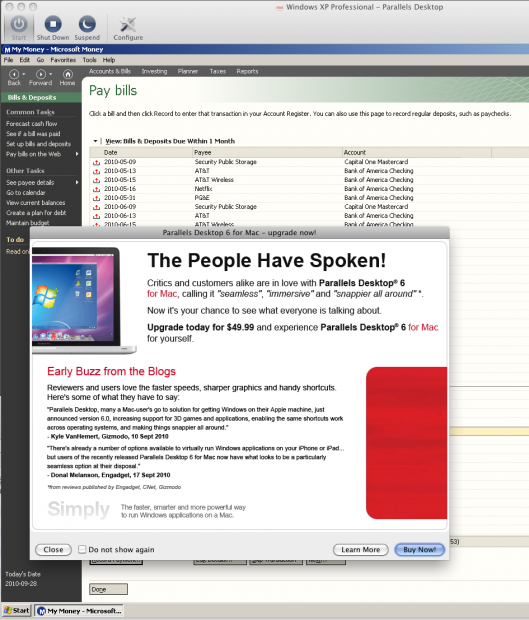I love my ISP
Not only do Webpass give me fast 45Mbps symmetrical access for $45/month, with no capricious restrictions or anticompetitive shenanigans, but they are also real mensches.

Not only do Webpass give me fast 45Mbps symmetrical access for $45/month, with no capricious restrictions or anticompetitive shenanigans, but they are also real mensches.

When you visit the Dell website, the first thing they force you to decide is whether you are a Home, Small Business or “Enterprise” business customer. At one point, the thin and light laptops were only available in the Enterprise section—perhaps plebs and small businesses are judged unworthy of appreciating the finer things in life, unlike the kleptocrats who run large corporations. We hoi polloi presumably should be content with our fate and make do with last year’s (decade’s?) technology.
When you search for products on Amazon, you have to select a “Department” to enable sorting by price. What do I care whether a microfiber cloth was filed under “Automotive” or “Electronics”? Taxonomies are inherently subjective, a fact librarians know well, but is surprisingly poorly understood outside the field.
Both cases illustrate what happens when a self-centered organization puts its internal structure and implementation details ahead of its customers.
Since you keep hitting me with these spammy popups no matter how many times I click on “Do not show again”, you leave me no choice but to switch to VirtualBox (much better software in any case, and less Windows integration means less chances a virus breaking out of the virtualized Windows ghetto.

Oh, and installing MacFuse without asking permission (unlike VMware Fusion): not cool.
Don’t let the door hit you on the way out.
In a triumph of hope over experience, I recently “upgraded” from Adobe CS3 Design Standard to CS5 Design Standard. I hardly ever use Photoshop any more since I started using Aperture and Lightroom (originally a Macromedia product, no matter what the lame “Adobe Photoshop Lightroom” face-saving branding may try to claim), the main driver for the purchase was actually InDesign CS5 and its ePub functions.
Of course, this is Adobe. Previous versions gratuitously included crud like a full Opera install (an older version, insecure, naturally) just to display a splash screen, or a full MySQL install to power Acrobat search. I never install Acrobat, of course, since that bloated and bug-ridden piece of garbage managed to steal the crown for most insecure software from Internet Explorer, no small feat.
Adobe does not want to confuse users with streamlined and efficient software, so they decided to include the mostly useless Growl on-screen notification program to nag you into registering. Increasing bloat and attack surface for malware is not a good idea, nor is interrupting creative people’s flow with interruptions. Of course, helping clients Get Things Done is a low priority at Adobe, as evidenced by their product choices.
You have to pity the Growl developers, whose reputation will suffer from guilt by association. I dislike interruptions and do not find it useful, but many people do and rave about it. They installed it by choice, not as a sneaky drive-by install for slimy marketing purposes.
Some more annoyances in CS5:
In other words, unlike Lightroom, CS5 is designed to be endured, not to delight.
One of the greatest features in the Webkit-based browsers (Apple’s Safari and Google Chrome) is WebSQLdatabase, the ability for a web site to store information in a SQLite database on your browser accessible via JavaScript. This allows web developers to build database-enabled applications that run entirely in the browser, without requiring a server. This is very useful for mobile devices, which in the US enjoy flaky network connectivity at best. One very handsome example is the iPad-optimized Every Time Zone webapp.
SQLite is probably the most important open-source project you have never heard of. It is a simple, streamlined and efficient embedded database. Firefox stores its bookmarks in it. Google distributes its database of phishing sites in that format. Sun’s industrial-strength Solaris operating system stores the list of services it runs on boot in it—if it were to fail, a server would be crippled so that is a pretty strong vote of confidence. Adobe Lightroom and Apple’s Aperture use it to store their database, as do most Mac applications that use the CoreData framework, and many iPhone apps. In other words, it is robust and proven mission-critical software that is widely yet invisibly deployed.
WebSQLdatabase basically makes the power of SQLite available to web developers trying to build apps that work offline, specially on mobile devices. No good deed goes unpunished, and the Mozilla foundation teamed up with unlikely bedfellow Microsoft to torpedo formal adoption of WebSQLdatabase as a web standard, on spurious grounds, and pushed an alternate standard called IndexedDB instead. To quote the Chromium team:
Q: Why this over WebSQLDatabase?
A: Microsoft and Mozilla have made it very clear they will not implement SQL in the browser. If you want to argue this is silly, talk to them, not me.
IndexedDB is several steps backwards. Instead of using powerful, expressive and mature SQL technology, it uses a verbose JavaScript B-tree API that is a throwback to the 1960s bad old days of hierarchical databases and ISAM, requires a lot more work from the developer, for no good reason. To add injury to insult, Firefox 4’s implementation of IndexedDB is actually built on top of SQLite. The end result will be that web developers will need to build a SQL emulation library on top of IndexedDB to restore the SQLite functionality deliberately crippled by IndexedDB. If there is one constant in software engineering, it is that multiple layers add brittleness and impair performance.
Of course, both Mozilla and Microsoft are irrelevant on mobiles, where WebKit has essentially won the day, so why should this matter? Microsoft has always been a hindrance to the development of the web, since they have to protect the Windows API from competition by increasingly capable webapps, but I cannot understand Mozilla’s attitude, except possibly knee-jerk not-invented-here syndrome and petulance at being upstaged by WebKit. WebSQLdatabase is not perfect—to reach its full potential, it needs and automatic replication and sync facility between the local database and the website’s own database, but it is light years ahead of IndexedDB in terms of power and productivity.
I am so irritated by Mozilla’s attitude that after 10 years of using Mozilla-based browsers, I switched today from Firefox to Chrome as my primary browser. Migrating was surprisingly easy. Key functionality like bookmark keywords, AdBlock, FlashBlock, a developer console, and the ability to whitelist domains for cookies, all have equivalents on Chrome. The main regressions are bookmark tags, and Chrome’s sync options are not yet equivalent to Weave‘s. At some point I will need to roll my own password syncing facility (Chrome stores its passwords in the OS X keychain, which is also used by Safari and Camino).